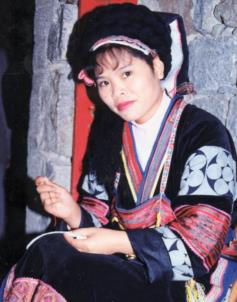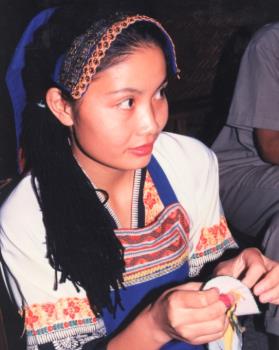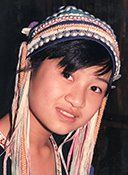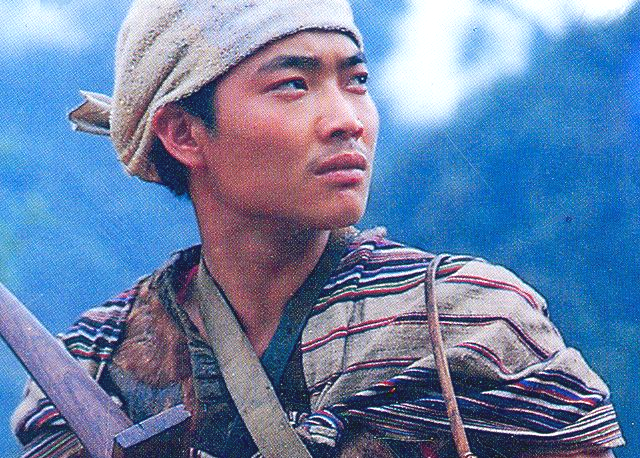
A Bouyei woman in traditional dress. [Paul Hattaway]
A Varied Background
The Bouyei are the second largest ethnic minority group in Guizhou, numbering nearly three million people. They are found in large numbers throughout southern Guizhou, and they spill across the borders into Guangxi, Yunnan, and other provinces. The center of the Bouyei could be said to be China's largest waterfall, Hongguoshu, which is surrounded by numerous Bouyei villages.
Historically, the Bouyei are considered part of the great Tai race, which is dispersed from central China all the way to Southeast Asia, and as far west as northeast India. Although the centuries have caused the Tai race to fragment into separate entities with their own customs and languages, there remain unmistakable ethno-linguistic similarities between the various Tai peoples. The Bouyei of Guizhou, for example, share much in common with the Zhuang of Guangxi—the largest ethnic minority group in China with a population of nearly 20 million people.
The Bouyei themselves, however, often claim Han ancestry, and are not keen to identify themselves as minority people. Missionary Samuel Clarke, who lived among them for decades, offered this theory regarding the historical background of the Bouyei:
"Wherever the Bouyei are found in Guizhou, they invariably assert that their ancestors were Chinese who came from the province of Jiangxi, and many of them name the prefecture and county from which their forefathers came....
Before the Chinese really occupied the province and systematically colonized it, there had been frequent wars and military demonstrations against the turbulent Miao. There were also on these occasions garrisons left in different parts of the country. Some of these soldiers took native women as wives, and formed separate communities, and are now called the 'Old Chinese.' Others of them, or the children of these garrison soldiers, married into Bouyei families. This marrying probably went on for a long period, so that in course of time many of them were really descended from the Chinese, and others were related to them by marriage.... As the Chinese are the superior and ruling race, it is natural that as many as can claim to be related to them should do so."
The great Tai peoples of Southeast Asia adopted Buddhism many centuries ago, and their identities are now interwoven with the religion, making them difficult to reach with the gospel of Jesus Christ. In contrast, groups like the Bouyei remain largely animistic, with the Chinese influences of ancestor worship and Daoism mixed in to their worldview.
Although animist peoples in Asia have generally been receptive to the claims of Christ and relatively easy to reach, the Bouyei have proven surprisingly difficult to penetrate with the gospel. Today, more than a century after missionaries first encountered them, less than one percent of Bouyei people are followers of Jesus.
Early Contact
One of the reasons that Evangelical missionaries struggled to make inroads into the Bouyei people was because the Catholics had already focused on the Bouyei for a century before the first Protestants arrived. A fear of Christianity had emerged among the Bouyei after waves of brutal persecution and martyrdoms over the decades. The lingering impression among many Bouyei was that Christianity is a religion that brings calamity upon its adherents, and consequently few were willing to embrace it.
Curtis Waters of the CIM is believed to be the first Evangelical missionary to target the Bouyei. In 1891 he established a base in Xingyi. The mission didn't last long however, with banditry and riots causing local officials to expel the missionaries from the area in 1902. Waters shifted his focus away from the Bouyei, and was involved with the A-Hmao revival that commenced a short time later.
Samuel Clarke of the CIM also made contact with the Bouyei in the late nineteenth century. He remarked:
"These people are difficult to reach. They live in separate communities generally away from the high roads. There are no inns and no tea shops in their villages, and strangers are not welcome among them. The first time I visited one of their villages I was doubtful as to the reception I should meet, so to reassure them I took my wife with me. When we entered the place everybody disappeared, and all doors were closed. We called out for hot water and sat down on a doorstep. At last, seeing we were not likely to move till we got some hot water, some was given to us. We were treated much the same way when we visited them a second time, but as we continued to go, their fear of us gradually wore away."
Samuel Clarke persevered, and spent more than 30 years serving Christ in Guizhou, although for much of the time he appears to have struggled with his feelings toward the Bouyei people. On one occasion Clarke unflatteringly wrote: "We do not think the claim of the Bouyei to be Chinese has done them any good. They appear to have all the defects of the Chinese and none of their better qualities.... The Chinese generally describe the Bouyei as crafty, lying, and dishonest, and that every Bouyei is a thief, and from what we know of them we should not feel justified in denying the charge."
The Clarkes found that the Bouyei living near Guiyang were much easier to visit and more hospitable to foreigners. They were able to rent a house in one Bouyei village, from where they visited other communities in the area. Discovering one of the greatest needs of the Bouyei was to educate their children, Clarke opened small schools in three villages, although he later lamented:
"In the evening many of them come and listen to the gospel. Men from other places have also come and asked me to open schools in their villages. If we had men and means, there is apparently no limit to the number of places we could occupy this way....
Dictionaries of their language have also been made, and a catechism and tracts have been translated into it. These people, like the Miao, have no written language of their own. They are vastly amused and interested when we take out a book and begin to read to them in their own tongue. Most of the Bouyei I have met can speak Chinese, so it is not necessary that the missionary among them should learn their language."
Before Samuel Clarke and his wife left the mission field for a furlough in 1898, they offered this grim prognosis of the Bouyei mission:
"The work among them has not been very encouraging thus far. They all seem utterly indifferent to things spiritual.... A few of them pretended an interest in the gospel and applied for baptism, but it was found in course of time that their thoughts were of the earth, and baptism was refused. Only three of them have been baptized, and these are by no means satisfactory."
Although the Gospel of Matthew was first translated into the Bouyei language in 1904, outreach among minority groups in the province soon focused on several receptive Miao tribes, where revival had broken out. The Bouyei were neglected, and it wasn't until 1919 that the next breakthrough was reported among them. Tellingly, Morris Slichter of the CIM (who was later murdered in 1927) seemed unaware of any previous Bouyei Christians when he wrote, "Six men were baptized. These are the first-fruits of the Bouyei tribe."
Brief Contact in the 1940s
As the revival continued among the A-Hmao and other groups, the success of that work seems to have sucked the oxygen out of other missionary efforts in the province, so that even large groups like the Bouyei remained almost completely untouched by the gospel. One missionary had lamented in 1934, "There are two million Bouyei in this province, and only about two Christians among them."
In 1948, Cyril Edwards and his co-workers visited a Bouyei village near Ziyun. They arrived after dark, having hiked through mud and driving rain for hours. They entered a house and were drying out their soaked clothing and shoes as the Bouyei returned home from working in the fields. Edwards recalled:
"They did come, gradually, a couple of rooms full. At first they were very much amused at the idea of being preached to, but their interest was soon aroused in the gospel message.... These Bouyei form a large part of the country population right across the south of this province, and nothing is being done to bring them the simple gospel message of salvation....
From this district we walked east for five days without passing through one place where there are any Christians or where there is any Christian testimony. In fact, apart from one or two more educated Chinese who in other places had heard of Christianity, no one had ever heard the Name of Jesus!"
The Bouyei Today

Many Bouyei women are skilled embroiderers. [Paul Hattaway]
With a population approaching that of entire countries like New Zealand and Norway, the Bouyei people remain severely unevangelized after more than a century of half-hearted efforts to introduce the gospel to them. Since the 1990s, a number of house church networks from other parts of China have attempted to reach the Bouyei, with moderate success.
Foreign Christians have also attempted to engage the Bouyei in the past few decades, but have generally found them to be uninterested in the gospel. Teams have travelled to Bouyei villages and began to show the Jesus film and distribute Christian literature, only to be arrested by the police. An American shared what happened after his small team was interrogated and ordered to leave the area:
"After packing our belongings, we stretched our hands out toward the unreached Bouyei homes. The valley was shrouded in a misty haze, pierced here and there by the early rays of sunlight. We prayed that God would watch over the lives of those who had expressed interest in the gospel; that He would cause the seeds that were sown to grow into a mighty harvest of souls. We prayed that there would be a spiritual awakening among this tribe, and that many of their names might be written in the Book of Life."
Foreign and local Christians did not give up trying to reach the Bouyei, and in 2008 one mission group reported a breakthrough: "Everywhere we went, the favor of God was on us. The villagers were very open to us and the message of the gospel. Several Bouyei believers will be coming out of their area for training soon. I believe in a short time we will start to see Bouyei churches sprout up."
Two years later the same group reported progress among the Bouyei, coupled with outreach to the Ge tribe in another part of Guizhou: "Among these two groups, we have already had a church-planting base for a year and a half. It was great being with the local brother who is running the operation on the ground. He has been very hard at work evangelizing and discipling new converts. It's amazing to see how God is using these local brothers and sisters to plant churches where there has never been any before."
Although reports have indicated the presence of pockets of Bouyei believers in various locations, no widespread turning to Christ has ever occurred among this large group. Today there are an estimated 4,000 Evangelical Christians among the 2.6 million Bouyei, which means just one out of every 650 Bouyei people is a follower of Jesus Christ.
The Almighty God has been patiently looking down from heaven for centuries, waiting for more of His ambassadors to visit the Bouyei and share the wonderful news that His beloved Son bled, died for their sins, and rose again for the justification of those who believe in Him.

© This article is an extract from Paul Hattaway's book 'Guizhou: The Precious Province'. You can order this or any of The China Chronicles books and e-books from our online bookstore.




